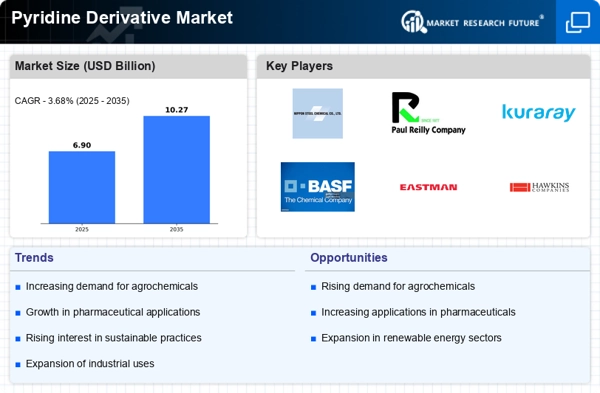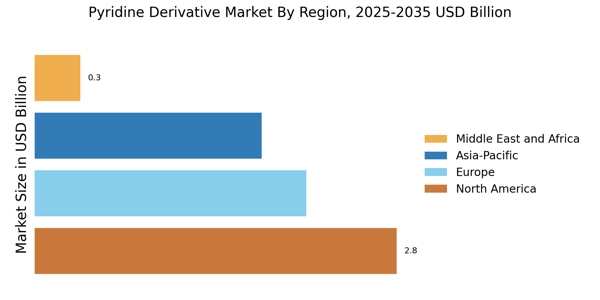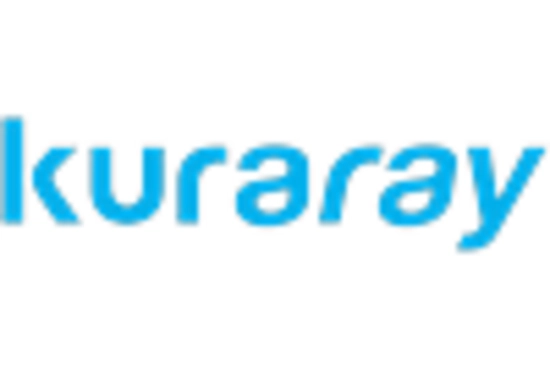Growth in the Chemical Industry
The Pyridine Derivative Market is poised for growth, largely attributed to the expanding chemical industry. Pyridine derivatives are integral to the production of various chemicals, including solvents, coatings, and rubber. The chemical sector is anticipated to witness a steady increase in demand, driven by industrialization and urbanization trends. According to recent data, the chemical manufacturing industry is expected to grow at a rate of around 4% annually. This growth trajectory suggests a corresponding rise in the demand for pyridine derivatives, as they are essential building blocks in the synthesis of numerous chemical products. Consequently, the Pyridine Derivative Market stands to benefit from this upward trend, as manufacturers align their production capabilities to meet the evolving needs of the chemical sector.
Expanding Applications in Agrochemicals
The Pyridine Derivative Market is experiencing a notable expansion due to the increasing utilization of pyridine derivatives in agrochemicals. These compounds serve as essential intermediates in the synthesis of various pesticides and herbicides, which are crucial for enhancing agricultural productivity. As the global population continues to rise, the demand for food security drives the need for effective agrochemical solutions. Reports indicate that the agrochemical sector is projected to grow at a compound annual growth rate of approximately 5.5% over the next few years. This growth is likely to bolster the Pyridine Derivative Market, as manufacturers seek to innovate and develop more efficient formulations that meet regulatory standards while ensuring environmental safety.
Rising Demand in the Electronics Sector
The Pyridine Derivative Market is also influenced by the burgeoning electronics sector, where pyridine derivatives are utilized in the production of electronic components. These compounds are employed in the synthesis of various materials, including semiconductors and conductive polymers. As technology advances and the demand for electronic devices escalates, the need for high-performance materials becomes increasingly critical. Market analysis suggests that the electronics industry is projected to grow at a compound annual growth rate of approximately 6% in the coming years. This growth is likely to create new opportunities for the Pyridine Derivative Market, as manufacturers strive to develop innovative solutions that cater to the evolving requirements of the electronics market.
Increased Focus on Research and Development
The Pyridine Derivative Market is benefiting from an increased focus on research and development activities across various sectors. Companies are investing significantly in R&D to explore new applications and improve the efficiency of pyridine derivatives. This trend is particularly evident in pharmaceuticals and agrochemicals, where innovative formulations are being developed to enhance product efficacy. The emphasis on R&D is expected to drive the market forward, as new discoveries and advancements could lead to the introduction of novel pyridine derivatives. Furthermore, the growing collaboration between academic institutions and industry players is likely to foster innovation, thereby propelling the Pyridine Derivative Market into new realms of application and efficiency.
Regulatory Support for Chemical Innovations
The Pyridine Derivative Market is likely to benefit from regulatory support aimed at fostering innovation within the chemical sector. Governments are increasingly recognizing the importance of sustainable chemical practices and are implementing policies that encourage the development of environmentally friendly products. This regulatory landscape is expected to create a favorable environment for pyridine derivatives, as manufacturers are incentivized to innovate and produce safer, more efficient compounds. The potential for regulatory support to drive market growth is underscored by the increasing emphasis on sustainability and safety in chemical manufacturing. As a result, the Pyridine Derivative Market may experience a surge in demand as companies align their products with regulatory expectations and consumer preferences.


















Leave a Comment